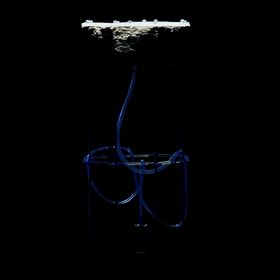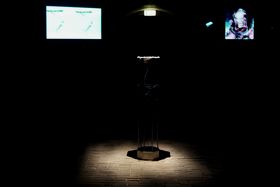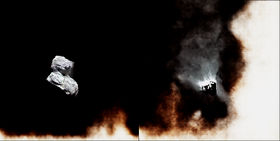Antti Tenetz, Perihelion 2.0 , super_gene_gold.

Perihelion 2.0 , super_gene_gold
Installation with videos, incubators, the gold-clustering bacteria Curvianus metalduransis and cyanobacteria of the species nostoc and nodularia in the chambers.
In Perihelion, Antti Tenetz combines images of space, celestial bodies, technology, space science and life as we know and imagine it. With the application of machine learning, Perihelion brings out dreamlike images of the worlds and beings of possible futures in space.
The metal-clustering bacteria Curvianus metalduransis is put in a forced evolution test with nano fluidic gold to encourage speculation on the possibility of creating conductive circuits and technologies in way similar to the cyanobacterial production of oxygen.
Generative adversarial networks (known as GANs in machine learning) have been trained by Tenetz. The images show the bacteria, vegetation and their growth patterns in the networks as well as imagery containing asteroids, comets and humans, connecting GANS with the themes of Perihelion. Together, the images and bacteria produce hybrid dreamlike entities, visions located in a potential deep space and future. They give rise to a metamorphic world and beings in which the living and the technological intersect.
Metalduransis bacteria have gone trough forced evolution test where conditions of environment in incubator are modified. Reduced nutrients, humidity and temperature simulate different environments in order to cultivate surviving colonies and breed more durable and resilient bacteria I order them to succeed in extreme environments like space and surface of planets like mars and other celestial bodies.
Neural network models are trained with different sets of Images starting from class of model organism microbes and coming to environment, humans in space and technosphere, machines used in space. Selected neural networks are selected and parameters of environment has been changed by artist in new training cycle. Analogy between biology and machine learning and its implications comes evident. Merging of biosphere and technosphere becomes total, even totalitarian process in controlled env. Side by side existing evolutive processes feeds each other in order to dream distant possible futures.
Antti Tenetz is a sub-arctic based artist. Through a practice of video, installation and biological arts he explores how humans, non-humans and machines may envision, dream, perceive and relate to changes in a hybrid environment where the biosphere and technosphere merge. He works in the interstices. between media arts, biological arts and urban art. His focus is on multi-disciplinary and multi-artistic collaboration between art and science is evident in his use of technologies such as drones, satellite tracking, game engines and machine learning. Tenetz’s works and collaborative projects have been exhibited in Finland and internationally, including at the Venice Biennale, Istanbul Biennale parallel program, Tate Modern Exchange program, Science Gallery Dublin and Lumipalloefekti exhibitions, X-Border, ISEA Istanbul, Pan-Barentz, and e-mobil art. He has also won three national snow-sculpting competitions.
Perihelion is created in collaboration with Biofilia – A Base for Biological Arts at Aalto University, the Cyanobacteria Research Group at the University of Helsinki, the Biocenter at Oulu University, the University of Adelaide, Waag Planet B, the International Lunar Exploration Working Group, and for technical assistance with machine learning, Hannu Töyrylä.
http://www.tenetz.com/
Interview with Antti Tenetz
This interview is conducted with Antti Tenetz by Bilge Hasdemir as part of the Outre: Encounters with Non/living Things exhibition.

`Outré: Encounters with Non/living Things` online exhibition











